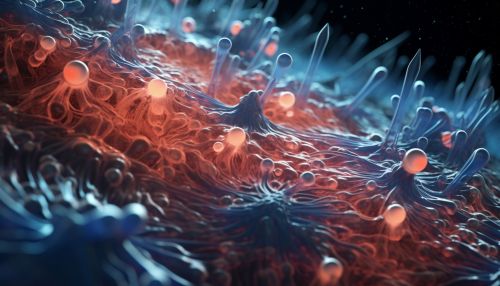Molecular Basis of Magnetotaxis in Bacteria
Introduction
Magnetotaxis is a behavior exhibited by certain types of bacteria that allows them to orient themselves and navigate in response to a magnetic field. This phenomenon is made possible by the presence of magnetosomes, which are intracellular structures containing magnetic mineral particles. The molecular basis of magnetotaxis in bacteria is a complex process involving a variety of genetic, biochemical, and biophysical factors.


Magnetosomes
Magnetosomes are unique organelles found in magnetotactic bacteria that contain magnetic mineral particles, usually magnetite (Fe3O4) or greigite (Fe3S4). These particles are enveloped by a lipid bilayer, and their formation is controlled by a specific set of genes known as the magnetosome gene island (MAI). The magnetosomes align themselves along the cell's long axis, forming a chain that acts as a cellular compass needle, enabling the bacteria to orient and navigate along magnetic field lines.
Magnetosome Gene Island (MAI)
The magnetosome gene island (MAI) is a large genomic region that contains a cluster of genes responsible for the biomineralization of magnetic particles and the formation of magnetosomes. The MAI is highly conserved among different species of magnetotactic bacteria, suggesting a common evolutionary origin. It includes genes encoding for proteins involved in magnetosome membrane formation, iron transport, and magnetite biomineralization.
Biomineralization Process
The biomineralization of magnetic particles within magnetosomes is a tightly controlled process that involves several steps. First, iron ions are transported into the magnetosome through specific iron transport proteins. Once inside the magnetosome, these ions are oxidized and precipitated as magnetite or greigite under the control of magnetosome proteins. The size, shape, and crystallographic orientation of the magnetic particles are also controlled by these proteins, ensuring the formation of a single magnetic domain that can respond to magnetic fields.
Magnetotaxis Mechanism
The mechanism of magnetotaxis involves the alignment of the chain of magnetosomes along the cell's long axis, creating a cellular compass needle. This allows the bacteria to orient themselves along magnetic field lines. The direction of movement is controlled by the flagellar motor, which can switch its rotational direction to move the bacterium forward or backward. The combination of magnetotaxis and chemotaxis, a behavior that allows bacteria to move towards or away from certain chemicals, enables magnetotactic bacteria to navigate effectively in their environment.
Ecological Significance
Magnetotactic bacteria play a significant role in the biogeochemical cycling of iron and sulfur in aquatic environments. By precipitating iron ions as magnetite, they contribute to the removal of iron from the water column. Additionally, some species of magnetotactic bacteria can reduce sulfate to sulfide, which is then precipitated as greigite. These processes can influence the geochemical properties of sediments and impact the availability of these elements for other organisms.
